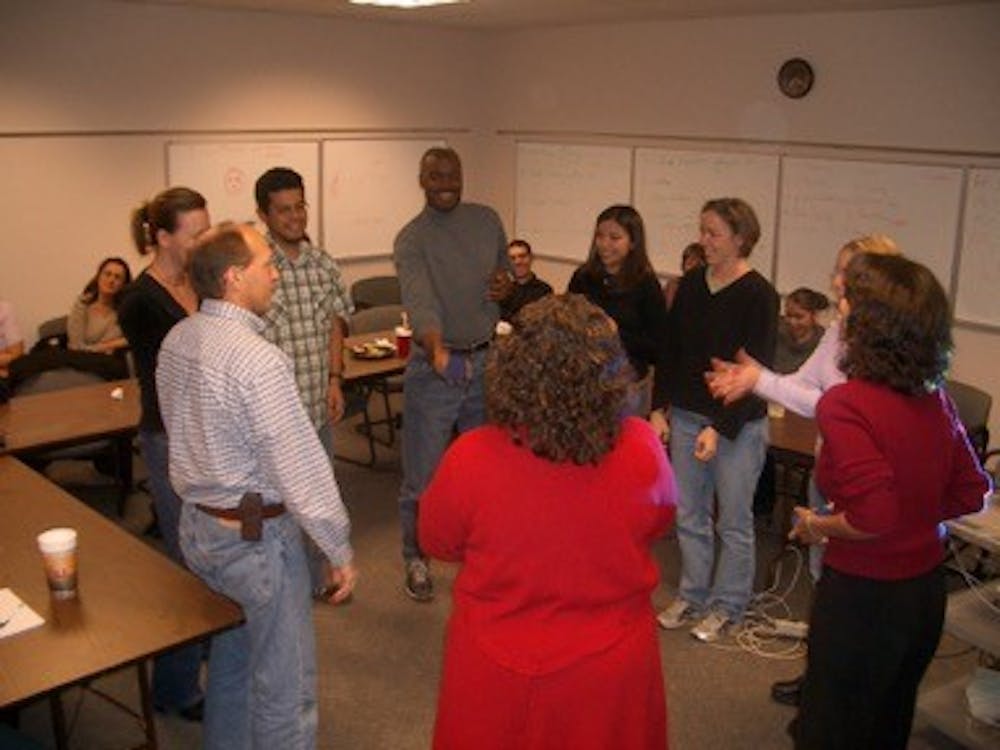 Community group leaders involved in the Bridges to High School program prepare to work with middle schoolers and their families. (Photo Courtesy of Nancy Gonzales)
Community group leaders involved in the Bridges to High School program prepare to work with middle schoolers and their families. (Photo Courtesy of Nancy Gonzales)The high school dropout rate for Hispanics in the U.S. has decreased by 9 percent drastically since 1990, according to the U.S. Department of Education’s National Center for Education Statistics.
However, it also shows Hispanic students are still more likely than students of any other U.S. ethnic group to not finish high school.
Faculty members from ASU’s Department of Psychology are working to further curb high school dropout rates in young Mexican Americans by creating a family-oriented program for middle school students in the Valley, ASU psychology professor Nancy Gonzales said.
“If you give families a resource and a way for them to effectively engage and make a difference, they are very enthusiastic to do so,” she said. “(The program shows) the strength of the family and the importance of engaging the family — of bringing families together with schools and kids around their shared mission of helping kids to be successful.”
 Community group leaders involved in the Bridges to High School program prepare to work with middle schoolers and their families. (Photo Courtesy of Nancy Gonzales)
Community group leaders involved in the Bridges to High School program prepare to work with middle schoolers and their families. (Photo Courtesy of Nancy Gonzales)She said the program, which is called Bridges to High School, has reached more than 500 students at four different Maricopa middle schools, and the program has shown surprisingly effective results.
Gonzales and her colleagues have organized an intensive educational experience for seventh-grade Mexican-American students and their parents that involves nine two-hour information sessions to cultivate a “positive life trajectory.”
The study has been going on for several years, and data collected has shown that students involved in the nine-session program have had significantly lower high school dropout rates and substance abuse rates than students of a control group.
Students in the control group attended just one two-hour Bridges to High School session.
“We’re trying to teach skills that we’ve learned from our understanding of general psychological principles and learning methods… that are going to be relevant to all groups (of people),” Gonzales said. “But we also want to be sensitive to the unique issues that families might face because of their cultural background.”
 Community group leaders involved in the Bridges to High School program prepare to work with middle schoolers and their families. (Photo Courtesy of Nancy Gonzales)
Community group leaders involved in the Bridges to High School program prepare to work with middle schoolers and their families. (Photo Courtesy of Nancy Gonzales)She said the results have prompted her to expand the program, and she wants to make it available online.
“One of the big challenges of taking a program like this and implementing it with large numbers of kids in large numbers of schools throughout the country is that (the program) is time consuming,” she said. “It’s hard to scale up something that is so intensive.”
Gonzales said she and her colleagues have spent a lot of time studying the program in order to determine which of its many aspects have the most significant effects on students’ wellbeing over time, which will make it easier to implement on a larger scale.
They are using what they learn to “streamline the program” by eliminating everything about the program that does not contribute to the results it yields.
Anne Mauricio, a professor in ASU’s Department of Psychology, said she hopes the program will spread to reach more students.
“It’s very important that programs that are efficacious … get out into the world,” she said. “In an ideal world, it would be a mandate that everyone have access to these programs.”
Mauricio said efficacious programs can have a positive effect on what she calls the “cascade model.”
“There’s the idea that kids more or less follow a trajectory,” she said. “That’s where the idea comes from that helping (kids) early affects them later. Kids who prevent initiation of or escalation of substance abuse in early, middle or late adolescence are likely to have more positive life trajectories.”
Larry Dumka, a professor at ASU’s School of Social and Family Dynamics, is also involved in the Bridges to High School program. He said the research he and his colleagues have conducted proves the value of family-oriented intervention is a tool to put young Mexican-Americans on a path to success.
“I’m passionate about this program’s potential to really help families promote the kinds of relationships that help kids achieve better in school,” he said.
Reach the reporter at megannphillips@asu.edu or follow her on Twitter @megannphillips
Like The State Press on Facebook and follow @statepress on Twitter.




